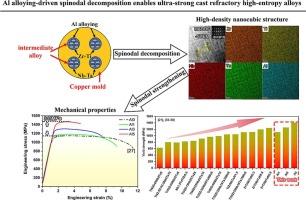Al alloying-driven spinodal decomposition enables ultra-strong cast refractory high-entropy alloys
IF 7.9
2区 材料科学
Q1 MATERIALS SCIENCE, MULTIDISCIPLINARY
引用次数: 0
Abstract
Strengthening in refractory high-entropy alloys (RHEAs) can be achieved through the formation of “compositional heterogeneity” at the atomic scale. Here, we chose Zr45Ti15Nb20Ta20 alloy with a single-phase body-centered cubic (BCC) structure as a matrix and added a small amount of Al to promote a unique spinodal decomposition. The results show that the introduction of Al-X negative mixing enthalpy induces the RHEAs spinodal decomposition to form a nanocubic structure in the form of a basket-like fabric morphology with a characteristic periodicity of 12 nm. Nanocubic structures consist of (Nb, Ta)-rich cubes and Zr-rich channels as well as generate strong localized strain fields at the interfaces. Spinodal decomposition strengthening enables the as-cast RHEA to achieve a yield strength of 1405 MPa. Periodically distributed nanostructures make dislocations move slowly, causing plugging and cross-slip, facilitating dislocation interactions, multiplication, and accumulation. In summary, the chemical heterostructure produced by spinodal decomposition has been remarkably effective in improving the strength of RHEAs.

铝合金驱动的spinodal分解使超高强度铸造难熔高熵合金成为可能
耐火高熵合金(RHEAs)的强化可以通过在原子尺度上形成“成分非均质性”来实现。本文选择了具有单相体心立方(BCC)结构的Zr45Ti15Nb20Ta20合金作为基体,并加入少量Al促进其独特的旋轴分解。结果表明,Al-X负混合焓的引入诱导了RHEAs的旋多分解,形成了篮状织物形态的纳米立方结构,其特征周期为12 nm;纳米立方结构由富含(Nb, Ta)的立方体和富含zr的通道组成,并在界面处产生强烈的局部应变场。分解强化使铸态RHEA的屈服强度达到1405 MPa。周期性分布的纳米结构使位错移动缓慢,导致堵塞和交叉滑移,促进位错相互作用、增殖和积累。综上所述,由旋多分解产生的化学异质结构在提高RHEAs强度方面非常有效。
本文章由计算机程序翻译,如有差异,请以英文原文为准。
求助全文
约1分钟内获得全文
求助全文
来源期刊

Materials & Design
Engineering-Mechanical Engineering
CiteScore
14.30
自引率
7.10%
发文量
1028
审稿时长
85 days
期刊介绍:
Materials and Design is a multi-disciplinary journal that publishes original research reports, review articles, and express communications. The journal focuses on studying the structure and properties of inorganic and organic materials, advancements in synthesis, processing, characterization, and testing, the design of materials and engineering systems, and their applications in technology. It aims to bring together various aspects of materials science, engineering, physics, and chemistry.
The journal explores themes ranging from materials to design and aims to reveal the connections between natural and artificial materials, as well as experiment and modeling. Manuscripts submitted to Materials and Design should contain elements of discovery and surprise, as they often contribute new insights into the architecture and function of matter.
 求助内容:
求助内容: 应助结果提醒方式:
应助结果提醒方式:


